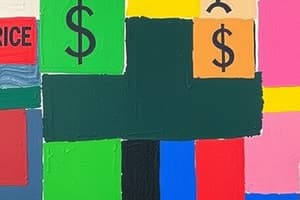Podcast
Questions and Answers
What is a price ceiling?
What is a price ceiling?
- A legal minimum on the price of a good
- A legal maximum on the price of a good or service (correct)
- A type of tax
- None of the above
What defines a binding price ceiling?
What defines a binding price ceiling?
A price ceiling is binding if it is below the equilibrium price.
What defines a non-binding price ceiling?
What defines a non-binding price ceiling?
A price ceiling is non-binding if it is above the equilibrium price.
What is a price floor?
What is a price floor?
What defines a binding price floor?
What defines a binding price floor?
What defines a non-binding price floor?
What defines a non-binding price floor?
What is the formula for consumer surplus?
What is the formula for consumer surplus?
What is the definition of welfare economics?
What is the definition of welfare economics?
What is total surplus?
What is total surplus?
What is the Laffer curve?
What is the Laffer curve?
Flashcards are hidden until you start studying
Study Notes
Price Controls
- Price Ceiling: A legal maximum price for a good or service.
- Binding: Exists when set below the equilibrium price, causing shortages.
- Non-binding: Exists when set above equilibrium price, having no effect on the market.
- Price Floor: A legal minimum price for a good.
- Binding: Occurs when price floor is above equilibrium price, creating surplus.
- Non-binding: Exists when floor is set below equilibrium price.
Economic Impact
- Rent Control and Minimum Wage: Can have different short-run and long-run effects on supply, demand, and market equilibrium.
- Per Unit Tax: Imposed on buyers/sellers, impacting market equilibrium, causing shifts in demand or supply curves.
Taxation
- Tax Incidence: Distribution of tax burden between buyers and sellers, influenced by elasticity.
- Deadweight Loss: Represents lost economic efficiency due to taxes; transactions do not occur post-tax between QT and QE.
- Laffer Curve: Demonstrates the relationship between tax rates and tax revenue, showing optimal tax rate exists.
Externalities
- Definitions: Uncompensated effects of one party's actions on others, leading to market inefficiencies. They can be positive or negative.
- Social vs. Private Costs:
- Private Costs: All costs incurred by the seller.
- Social Costs: Include private costs plus external costs affecting third parties.
- Market vs. Social Quantities: Markets may overproduce with negative externalities or underproduce with positive externalities.
Economic Welfare
- Consumer Surplus: Difference between willingness to pay and actual payment, indicating benefits to consumers in a transaction.
- Producer Surplus: Difference between the price received and the minimum price threshold at which sellers are willing to sell.
- Total Surplus: Sum of consumer and producer surplus, representing overall welfare in the market.
Competition and Market Efficiency
- Efficiency: Achieved when total surplus is maximized. Resources allocated when buyers with the highest willingness to pay and lowest cost producers interact.
- Perfect Competition Assumptions: Marginal cost equals marginal benefit, indicating optimal resource allocation.
Role of Government
- Corrective Taxes/Pigouvian Taxes: Designed to address negative externalities by aligning private incentives with social costs.
- Public Goods vs. Common Resources: Public goods provide non-excludable benefits without rivalry, whereas common resources are rival but non-excludable.
Production Costs
- Total Revenue: Income from sales of goods/services.
- Total Cost: Overall expenditure on production, including both explicit (out-of-pocket) and implicit (opportunity cost) costs.
- Short-run vs. Long-run Costs: Short-run includes fixed costs; long-run involves all variable inputs.
Scale of Production
- Economies of Scale: Cost advantages as production scale increases, reducing average total costs.
- Diseconomies of Scale: Increased average total costs as production expands beyond optimal capacity.
Transactional Dynamics
- Coase Theorem: Suggests that with clear property rights and no transaction costs, parties can negotiate to reach efficient outcomes regarding resource allocation.
- Transaction Costs: Expenses incurred in the process of bargaining or enforcing agreements.
Goods Classification
- Excludability: Ability to prevent usage by others; categorizes goods as excludable or non-excludable.
- Rivalry: Degree to which one user's consumption reduces availability for others, determining the classification as rival or non-rival goods.
Common Resource Management
- Tragedy of the Commons: Overuse of shared resources due to lack of individual accountability and incentives.
- Government Role: Addressing overuse through regulations or policies to manage common resources sustainably.
Studying That Suits You
Use AI to generate personalized quizzes and flashcards to suit your learning preferences.



